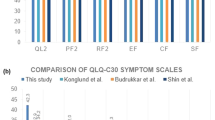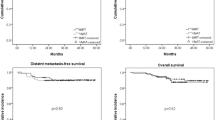Background and Purpose:
Stereotactic radiosurgery (SRS) and also fractionated stereotactic radiotherapy (SRT) offer high local control (LC) rates (> 90%). This study aimed to evaluate three-dimensional (3-D) tumor volume (TV) shrinkage and to assess quality of life (QoL) after SRS/SRT.
Patients and Methods:
From 1999 to 2005, 35/74 patients were treated with SRS, and 39/74 with SRT. Median age was 60 years. Treatment was delivered by a linear accelerator. Median single dose was 13 Gy (SRS) or 54 Gy (SRT). Patients were followed up ≥ 12 months after SRS/SRT. LC and toxicity were evaluated by clinical examinations and magnetic resonance imaging. 3-D TV shrinkage was evaluated with the planning system. QoL was assessed using the questionnaire Short Form-36.
Results:
Median follow-up was 50/36 months (SRS/SRT). Actuarial 5-year freedom from progression/overall survival was 88.1%/100% (SRS), and 87.5%/87.2% (SRT). TV shrinkage was 15.1%/40.7% (SRS/SRT; p = 0.01). Single dose (< 13 Gy) was the only determinant factor for TV shrinkage after SRS (p = 0.001). Age, gender, initial TV, and previous operations did not affect TV shrinkage. Acute or late toxicity (≥ grade 3) was never seen. Concerning QoL, no significant differences were observed after SRS/SRT. Previous operations and gender did not affect QoL (p > 0.05). Compared with the German normal population, patients had worse values for all domains except for mental health.
Conclusion:
TV shrinkage was significantly higher after SRT than after SRS. Main symptoms were not affected by SRS/SRT. Retrospectively, QoL was neither affected by SRS nor by SRT.
Hintergrund und Ziel:
Die stereotaktische Radiochirurgie (SRS) und die stereotaktische Radiotherapie (SRT) erreichen Tumorkontrollraten von > 90%. Diese Studie hatte zum Ziel, die Tumorvolumenregression und die Lebensqualität (QoL) nach SRS/SRT zu evaluieren.
Patienten und Methodik:
Zwischen 1999 und 2005 wurden 35/74 Patienten mit einer SRS und 39/74 mit einer SRT behandelt. Das mediane Alter betrug 60 Jahre. Die Bestrahlungen erfolgten mit einem Linearbeschleuniger (6-MV-Photonen) mit einer medianen Einzeldosis von 13 Gy (SRS) oder mit einer Gesamtherddosis von 54 Gy (SRT). Lokale Kontrolle und Toxizität wurden mittels klinischer Untersuchungen und magnetresonanztomographischer Kontrollen, die Tumorvolumenregression am Planungssystem ≥ 12 Monate nach SRS/SRT evaluiert. Die QoL wurde 12 Monate nach SRS/SRT mit dem Fragebogen Short Form-36 evaluiert.
Ergebnisse:
Die mediane Nachbeobachtungszeit betrug 50/36 Monate (SRS/SRT). Das progressionsfreie 5-Jahres-Überleben und das 5-Jahres-Gesamtüberleben betrugen 88,1%/100% (SRS) und 87,5%/87,2% (SRT). Die Tumorvolumenregression lag bei 15,1%/40,7% (SRS/SRT; p = 0,01). Eine Einzeldosis (< 13 Gy) war der einzige determinierende Faktor der SRS (p = 0,001). Alter, Geschlecht und Voroperationen hatten keinen Einfluss auf die Tumorvolumenregression. Akut- oder Spättoxizität (≥ Grad 3) trat nicht auf. Hinsichtlich der QoL konnten keine signifikanten Unterschiede zwischen SRS/SRT ermittelt werden. Voroperationen oder Geschlecht hatten keinen Einfluss (p > 0,05). Im Vergleich zur deutschen Normalbevölkerung wiesen die Patienten schlechtere Werte für alle Domänen außer für „mental health“ auf.
Schlussfolgerung:
Die Tumorvolumenregression war nach SRT signifikant höher als nach SRS, wodurch die Hauptsymptome nicht beeinflusst wurden. Die QoL wurde weder durch SRS noch durch SRT beeinträchtigt.
Similar content being viewed by others
References
Alheit H, Dornfeld S, Dawel M, et al. Patient position reproducibility in fractionated stereotactically guided conformal radiotherapy using the BrainLab mask system. Strahlenther Onkol 2001;177:264–8.
Andrews DW, Suarez O, Goldman HW, et al. Stereotactic radiosurgery and fractionated stereotactic radiotherapy for the treatment of acoustic schwannomas: comparative observations of 125 patients treated at one institution. Int J Radiat Oncol Biol Phys 2001;50:1265–78.
Chan AW, Black P, Ojemann RG, et al. Stereotactic radiotherapy for vestibular schwannomas: favorable outcome with minimal toxicity. Neurosurgery 2005;57:60–70.
Chen JC, Giannotta SL, Yu C, et al. Radiosurgical management of benign cavernous sinus tumors: dose profiles and acute complications. Neurosurgery 2001;48:1022–32.
Chopra R, Kondziolka D, Niranjan A, et al. Long-term follow-up of acoustic schwannoma radiosurgery with marginal tumor doses of 12 to 13 Gy. Int J Radiat Oncol Biol Phys 2007;68:845–51.
Combs SE, Thilmann C, Debus J, et al. Long-term outcome of stereotactic radiosurgery (SRS) in patients with acoustic neuromas. Int J Radiat Oncol Biol Phys 2006;64:1341–7.
Combs SE, Volk S, Schulz-Ertner D, et al. Management of acoustic neuromas with fractionated stereotactic radiotherapy (FSRT): long-term results in 106 patients treated in a single institution. Int J Radiat Oncol Biol Phys 2005;63:75–81.
Fokas E, Wacker U, Gross MW, et al. Hypofractionated stereotactic reirradiation of recurrent glioblastomas. A beneficial treatment option after high-dose radiotherapy? Strahlenther Onkol 2009;185:235–40.
Friedman WA, Bradshaw P, Myers A, et al. Linear accelerator radiosurgery for vestibular schwannomas. J Neurosurg 2006;105:657–61.
Fuss M, Debus J, Lohr F, et al. Conventionally fractionated stereotactic radiotherapy (FSRT) for acoustic neuromas. Int J Radiat Oncol Biol Phys 2000;48:1381–7.
Geyer P, Blank H, Evers C, et al. Filmless evaluation of the mechanical accuracy of the isocenter in stereotactic radiotherapy. Strahlenther Onkol 2007;183:76–80.
Hasegawa T, Fujitani S, Katsumata S, et al. Stereotactic radiosurgery for vestibular schwannomas: analysis of 317 patients followed more than 5 years. Neurosurgery 2005;57:257–65.
Hempel JM, Hempel E, Wowra B, et al. Functional outcome after gamma knife treatment in vestibular schwannoma. Eur Arch Otorhinolaryngol 2006;263:714–8.
Henzel M, Gross MW, Hamm K, et al. Significant tumor volume reduction of meningiomas after stereotactic radiotherapy: results of a prospective study. Neurosurgery 2006;59:1188–94.
Henzel M, Hamm K, Gross MW, et al. Fractionated stereotactic radiotherapy of glomus jugulare tumors. Local control, toxicity, symptomatology, and quality of life. Strahlenther Onkol 2007;183:557–62.
International Commission on Radiation Units and Measurements. ICRU report 50: Prescribing, recording and reporting photon beam therapy. Washington: International Commission on Radiation Units and Measurements, Inc., ICRU, Bethesda, MD, USA 1993.
Janda M, Newman B, Obermair A, et al. Impaired quality of life in patients commencing radiotherapy for cancer. Strahlenther Onkol 2004;180:78–83.
King JT Jr, McGinnis KA, Roberts MS. Quality of life assessment with the Medical Outcomes Study Short Form-36 among patients with cervical spondylotic myelopathy. Neurosurgery 2003;52:113–21.
Koh ES, Millar BA, Ménard C, et al. Fractionated stereotactic radiotherapy for acoustic neuroma: single-institution experience at the Princess Margaret Hospital. Cancer 2007;109:1203–10.
Lunsford LD, Niranjan A, Flickinger JC, et al. Radiosurgery of vestibular schwannomas: summary of experience in 829 cases. J Neurosurg 2005;102:Suppl:195–9.
Mathieu D, Kondziolka D, Flickinger JC, et al. Stereotactic radiosurgery for vestibular schwannomas in patients with neurofibromatosis type 2: an analysis of tumor control, complications, and hearing preservation rates. Neurosurgery 2007;60:460–70.
Meijer OW, Weijmans EJ, Knol DL, et al. Tumor-volume changes after radiosurgery for vestibular schwannoma: implications for follow-up MR imaging protocol. AJNR Am J Neuroradiol 2008;29:906–10.
Rubin P, Constine LS, Fajardo LF, et al., RTOG Late Effects Working Group. Overview. Late Effects of Normal Tissues (LENT) scoring system. Int J Radiat Oncol Biol Phys 1995;31:1041–2.
Seegenschmiedt MH. Interdisciplinary documentation of treatment side effects in oncology. Present status and perspectives. Strahlenther Onkol 1998;174:Suppl 3:25–9.
Selch MT, Ahn E, Laskari A, et al. Stereotactic radiotherapy for treatment of cavernous sinus meningiomas. Int J Radiat Oncol Biol Phys 2004;59:101–11.
Selch MT, Pedroso A, Lee SP, et al. Stereotactic radiotherapy for the treatment of acoustic neuromas. J Neurosurg 2004;101:Suppl 3:362–72.
Williams JA. Fractionated stereotactic radiotherapy for acoustic neuromas. Int J Radiat Oncol Biol Phys 2002;54:500–4.
Yang SY, Kim DG, Chung HT, et al. Evaluation of tumour response after gamma knife radiosurgery for residual vestibular schwannomas based on MRI morphological features. J Neurol Neurosurg Psychiatry 2008;79:431–6.
Zabel-du Bois A, Ackermann B, Hauswald H, et al. Influence of intravenous contrast agent on dose calculation in 3-D treatment planning for radiosurgery of cerebral arteriovenous malformations. Strahlenther Onkol 2009;185:318–24.
Author information
Authors and Affiliations
Corresponding author
Rights and permissions
About this article
Cite this article
Henzel, M., Hamm, K., Sitter, H. et al. Comparison of Stereotactic Radiosurgery and Fractionated Stereotactic Radiotherapy of Acoustic Neurinomas According to 3-D Tumor Volume Shrinkage and Quality of Life. Strahlenther Onkol 185, 567–573 (2009). https://doi.org/10.1007/s00066-009-1959-y
Received:
Accepted:
Published:
Issue Date:
DOI: https://doi.org/10.1007/s00066-009-1959-y
Key Words:
- Stereotactic radiosurgery
- Stereotactic radiotherapy
- Acoustic schwannomas
- Tumor volume shrinkage
- Quality of life




